Introduction
The global economic impact of termites is estimated to be at $40 billion annually. Subterranean termites are responsible for about 80% of the total economic impact (Rust and Su 2012). Your home is a large investment. Termite prevention and control should be a priority and incorporated into your general home maintenance plan, which may include an annual renewal inspection by a trained and licensed termite inspector.
Termites generally require a pest management professional for control, but there are many things that you can do to prevent infestations. This guide is intended to help you make an informed choice on the best termite protection for you and contains the following information. Oi (2022) contains more in-depth information on the evolution of termite control.
Termites 101, an Overview
Summary of Termite Types and Methods of Control
Termite species can be regional, but termite groups (e.g., dampwood, drywood, subterranean) and control methods are nationally recognized. Check with your state and local UF/IFAS Extension offices if you have questions about identification and control.
Two of the most common groups of termites that homeowners encounter are drywood termites and subterranean termites. Dampwood termites can be occasionally found in homes (Figure 1). The "higher termites," conehead (Nasutitermes corniger) and the Florida dark-wing termites (Amitermes floridensis), have been found infesting structures in Florida only, and only occasionally (Figures 14–17). Table 1 contains a summary of control options for the most common wood-destroying organisms.
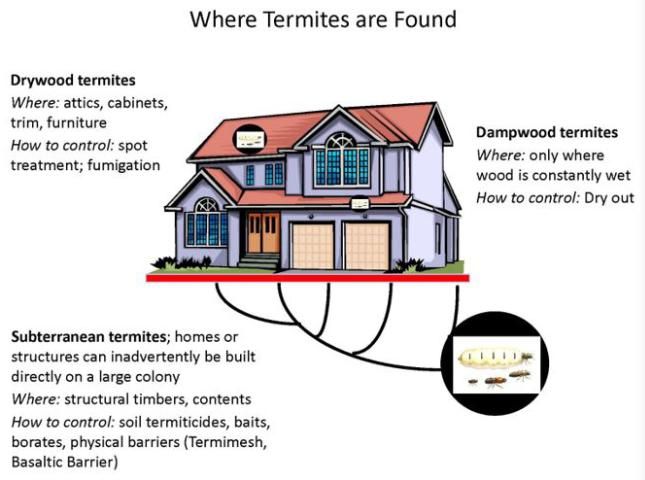
Credit: Nan-Yao Su, UF/IFAS
What is at risk of termite damage in my home?
Termites have a unique ability to digest cellulose, which is one of the most abundant materials on Earth. Cellulose can be found in wood and paper products. Thus, termites can damage structural timbers such as wooden studs, other framing material, and wooden trim such as baseboards and crown molding (Figure 2).
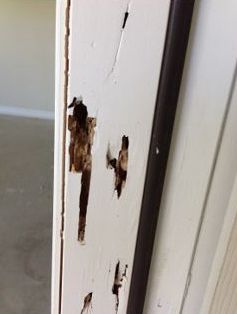
Credit: Faith Oi, UF/IFAS
Termites also can damage the contents of homes, including cabinetry, furniture, books, and stored items (Figure 3).

Credit: Faith Oi, UF/IFAS
Termites are known to damage non-cellulosic material as well. They can easily tunnel through construction elements such as rigid foam board insulation and spray foam insulation (Figure 4).
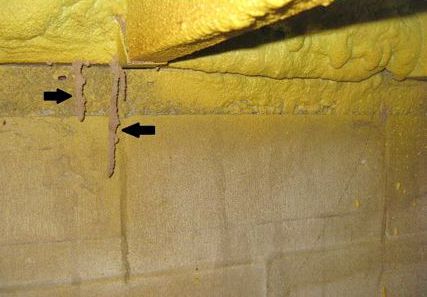
Credit: Faith Oi, UF/IFAS
Be aware that many pest control companies will not place a warranty on homes with spray foam insulation (Figure 5).
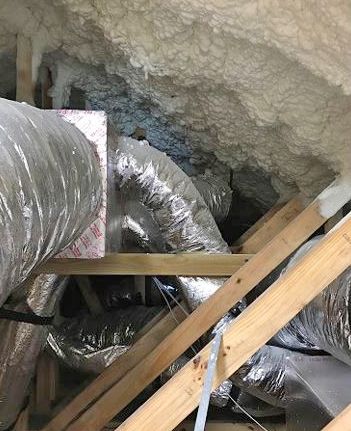
Credit: Faith Oi, UF/IFAS
Spray foam can create a situation where thorough inspections and effective termite treatment cannot be conducted (Forschler 2022).
One Reason That Termites Are Difficult to Control: The Colony
Termites live in colonies that can contain hundreds to millions of individuals, depending on the species. With some termites, such as the Formosan subterranean termites, the colony foraging territory can cover over an acre. In other species such as the drywood, Cryptotermes, it may take years for damage to be detected.
The colony contains different castes (i.e., forms): workers, soldiers, and reproductive (Figures 18, 26, and 42)
- Workers are the most numerous and do the damage in the colony with their chewing mouthparts. They have been called "white ants" because of their cream-colored appearance. They are about 1/8 of an inch long.
- Soldiers have "sclerotized" (darkened) heads and make up a much smaller percentage of the colony. They defend the colony and have other important functions. They are about 1/8 of an inch long.
- "Swarmers" are a winged reproductive form, also called alates. Alates with wings are about ¼ to 3/8 of an inch long and are the most helpful form for termite identification, followed by soldiers, then workers. Swarmers are only present during the spring and possibly fall.
Termite Identification
The most important part of termite control is obtaining a correct identification. Treatments for different species are drastically different, and most of them are costly. It is important to differentiate correctly between termites and ants and between different groups (Figure 6).
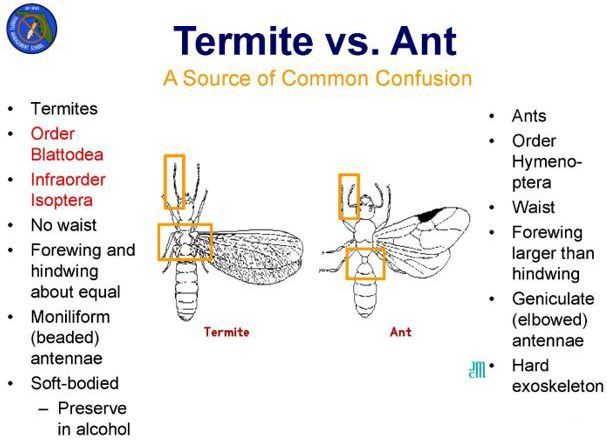
Credit: Jane Medley, UF/IFAS
Free termite identification. The termite researchers at the UF/IFAS Fort Lauderdale Research and Education Center will identify your termites for free! Follow the directions at this link to submit a sample: https://flrec.ifas.ufl.edu/termites-in-florida/send-samples/. They maintain a termite distribution map for Florida: https://flrec.ifas.ufl.edu/termites-in-florida/termite-distribution/. They are in the process of collecting information from other states.
Many states offer identification services through Extension. Fees are usually nominal compared to the cost of damage to your home. Click on your state at this link to begin the search: https://nifa.usda.gov/land-grant-colleges-and-universities-partner-website-directory?state=All&type=Extension
Some known insect identification clinics:
Auburn University: https://www.aces.edu/blog/topics/counties-statewide/plant-diagnostic-auburn lab-forms/ , or search for “Insect Identification Record Form, ANR-2317”
North Carolina State University: https://pdic.ces.ncsu.edu/how-to-submit/
Texas A&M: https://citybugs.tamu.edu/idhelp/
University of California, Riverside: https://entomology.ucr.edu/diagnostics-and-identification
UF/IFAS Insect ID Lab: http://entnemdept.ufl.edu/insectid/
University of Georgia: https://extension.uga.edu/programs-services/structural-pest-management/insect-weed-id.html
University of New Hampshire: https://extension.unh.edu/programs/insect-identification-services
Virginia Tech: https://www.ento.vt.edu/idlab.html
How to Submit a Termite Sample for Identification
If you plan to submit termites for identification, please place as many termites as you can collect in a small, tightly sealed container of hand sanitizer or rubbing alcohol (70% isopropyl alcohol) (Figure 7). The winged swarmers and soldiers are best for identification. Workers are the most numerous in the colony but the most difficult to use in identification.
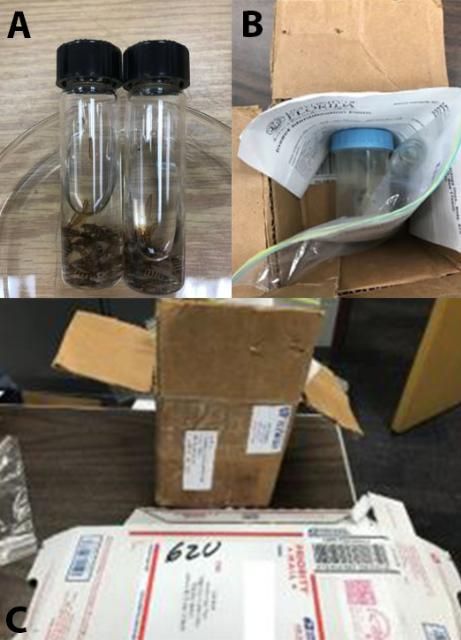
Credit: Faith Oi, UF/IFAS
Do not mail termites in a plastic bag placed in an envelope because important characteristics are crushed during delivery (Figure 8). If you plan to mail the sample, place the container in a box.
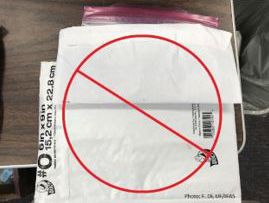
Please include the following information: Name, how best to contact you (e.g., email, phone number) date, location (address) collected, where collected (i.e., inside or outside home, door or window framing, wooden studs, etc.). Some insect identification laboratories have fillable forms with questions that can aid in identification. See example: https://edis.ifas.ufl.edu/pdffiles/SR/SR02200.pdf
Submitting pictures of termite damage can be helpful, but generally insect identification requires a sample of the actual insect. The vast majority of photographs submitted do not include the characteristics needed for identification and are not clear enough.
Termite Prevention
Homeowners can help prevent termite infestations by implementing good home maintenance practices. Keys to termite prevention include minimizing moisture, minimizing food sources, and making your home easier to inspect. Examples:
- Eliminate wood-to-ground contact (Figure 9).
- Remove wooden debris such as lumber and branches from property.
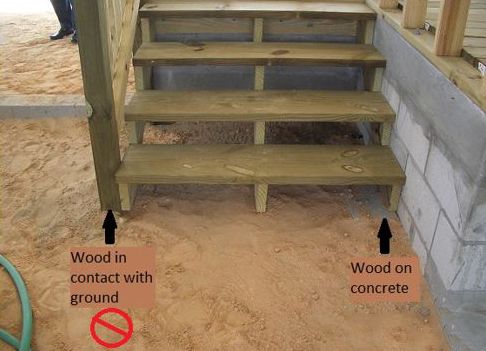
Credit: Faith Oi, UF/IFAS
- Stack firewood away from your home or any structure you want to protect.
- Keep an inspection space of at least 6 inches from the bottom of wall sidings and the soil or mulch line (Figure 10).
- Inspection spaces allow termite tubes to be detected (Figure 11).
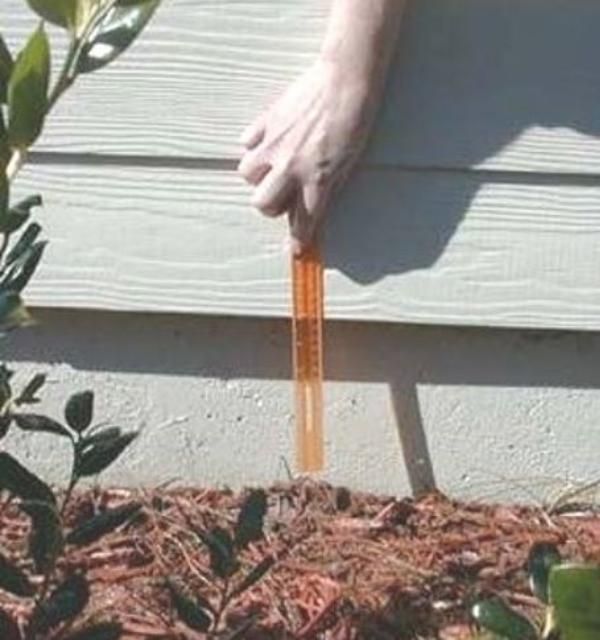
Credit: Faith Oi, UF/IFAS
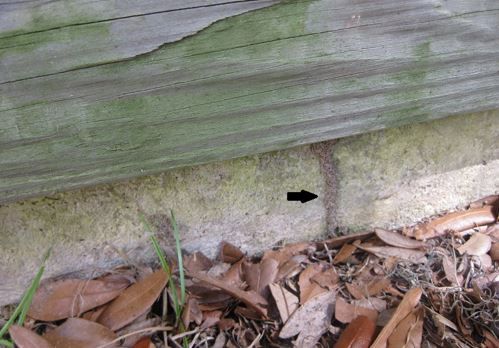
Credit: Faith Oi, UF/IFAS
- Ensure that water runs from the structure, not toward it.
- Direct A/C drainage lines away from your house.
- Fix leaks.
- Direct irrigation heads away from walls (Figure 12).
- Install gutters to manage the flow of water away from your home (Figure 13).
- Do not place or store items like rain barrels, compost bins, or other items that hold moisture at ground level within 2 feet of the foundation of your home.

Credit: Faith Oi, UF/IFAS
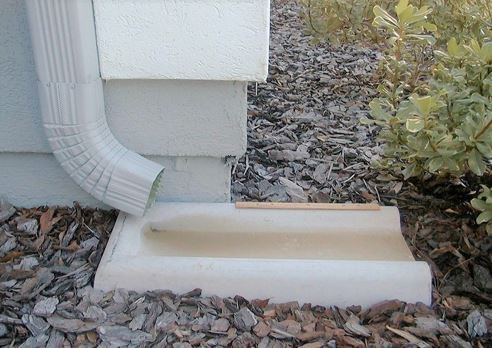
Credit: Faith Oi, UF/IFAS
- Place landscape plants at least 2 feet away from exterior walls (Figure 14).
- Account for future growth.
- Remember that improper plant placement will create conditions attractive to termites, and that may void your termite warranty (Figure 15).
- Avoid using wooden landscape timbers for edging.
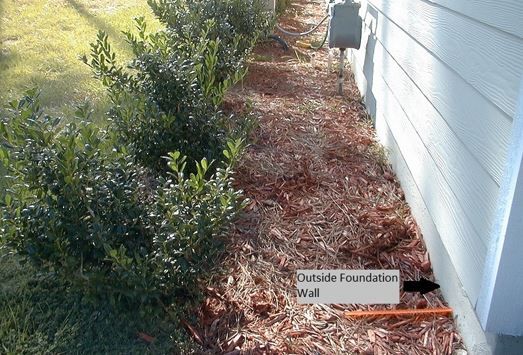
Credit: Faith Oi, UF/IFAS
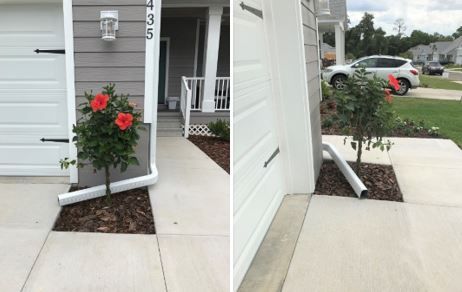
Credit: Faith Oi, UF/IFAS
- Keep soffits in good repair and screen vents to help prevent termite swarmers and other pests from entering attics. Drywood termites more commonly infest soffit and attic areas.
- Trim tree and shrub branches away from walls and roofs (Figure 16).
- Branches must not touch the roof of a structure. Subterranean termites can use branches as bridges to access structures (Figure 17).

Credit: Faith Oi, UF/IFAS
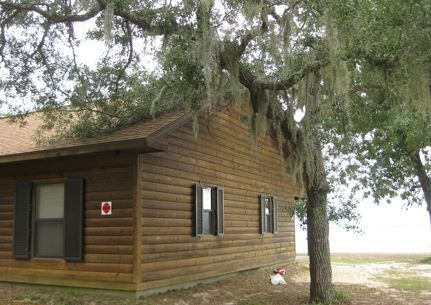
Credit: Faith Oi, UF/IFAS
- Consider contracting the services of a pest control company with experience and certifications in termite control to do an "annual renewal inspection."
- An annual renewal inspection is an inspection that is done on a year-to-year basis by someone who should be trained in how to recognize evidence of termites and potential problems.
- Some states require additional training to do these types of inspections with proof of training recorded on identification cards.
- Some states separate the annual renewal inspection from an inspection for the purposes of a real estate transaction.
Details of Termite Types, Evidence of Infestation, and Termite Control Methods
This section is designed to help you determine what type of termite you have and control options to consider. Table 1 in the section titled "Summary of Termite Types and Methods of Control," above, summarizes control options for common wood-destroying organisms. Termite prevention includes an annual inspection by a pest-management professional trained in the identification and control of termites and other wood-destroying organisms.
Dampwood Termites
- Require a wet (i.e., free water) environment. Often found in trees.
- Signs of dampwood termites: mix of loose and clumped pellets (Figure 18). Examples of damage (Figure 19) and live dampwood termites (Figure 20) in pictures below.
- Control: Drying the infested area is usually enough to control dampwoods. Drying may entail fixing roof and water leaks if the wood is not too decomposed. Wood replacement and moisture prevention are effective. It is possible to use borate-containing products such as Bora-Care® because the moisture in the wood will enhance the penetration of the product. Caution: Borates are toxic to plants. Do not use on live plants.
- Zootermopsis spp. are found in the Pacific Northwest. Neotermes spp. can be found in Florida and coastal southwestern states.
- More information on the Florida dampwood termite: http://entnemdept.ufl.edu/creatures/urban/termites/neotermes.html
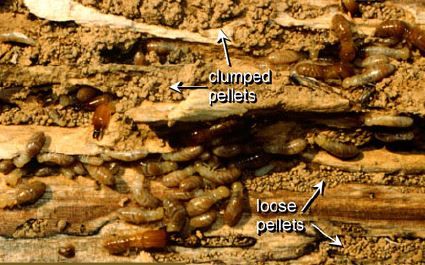
Credit: Rudolf H. Scheffrahn, UF/IFAS

Credit: Rudolf H. Scheffrahn, UF/IFAS
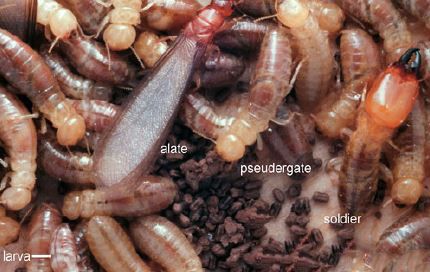
Credit: Rudolf H. Scheffrahn, UF/IFAS
Drywood Termites
Infestations are usually localized and in sound wood. Drywood termite colonies are not connected to the ground, so their galleries do not have mud in them (Figure 21). Colonies are often contained in a single piece of wood because colonies tend to remain relatively small. Galleries are smooth, going across the grain of the wood, and can extend for several feet. Evidence includes 6-sided pellets (Figure 22) that are pushed out of the colony through kickholes that are about the size of a pen tip (Figure 23). Pest control professionals often describe frass as "sand-like" particles. They also describe swarmer wings as being "iridescent" in color. Some drywood termites have soldiers with heads that are sometimes referred to as looking like a burnt matchstick. This is called a phragmotic head (Figure 24). Comprehensive information on drywood termites and their control can be found here: http://ipm.ucanr.edu/PMG/PESTNOTES/pn7440.html.
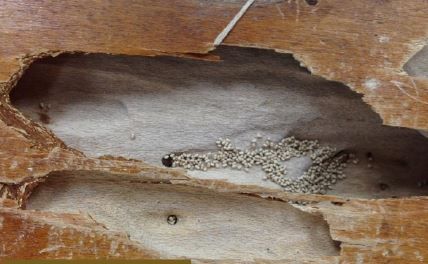
Credit: Faith Oi, UF/IFAS
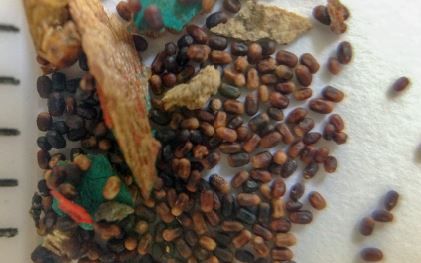
Credit: Faith Oi, UF/IFAS
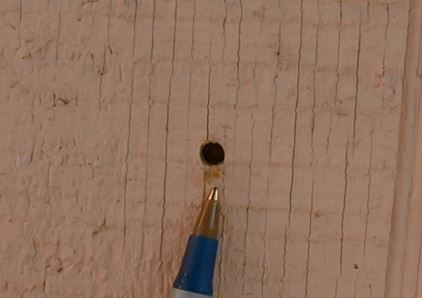
Credit: Faith Oi, UF/IFAS
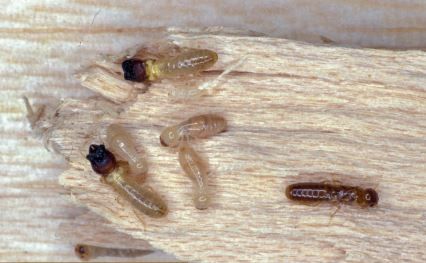
Credit: J. Castner, UF/IFAS
The most common control methods for drywood termites:
- Replace infested wood, usually if limited to door or window trim.
- Remove infested furniture or other items having termite damage.
- Spot treat with products labeled for drywood termites.
- Requires thorough inspection to find drywood termites for spot treatments to be successful.
- Fumigation (Figure 25).
- Is highly effective. Fumigation essentially kills everything in the structure and is a "reset button" for drywood termites.
- Fumigation is heavily regulated.
- Requires products that are designated as "restricted use."
- California and Florida do the most fumigations in the country.
- The Florida Department of Agriculture and Consumer Services has developed a helpful list of frequently asked questions. Most are applicable across the United States:
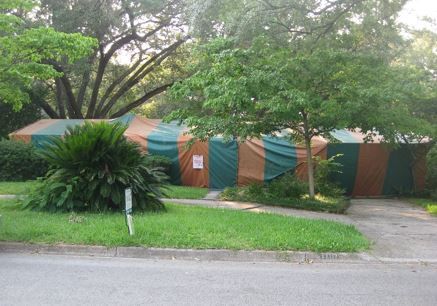
Credit: Faith Oi, UF/IFAS
Subterranean Termites
Subterranean termites usually reside in the ground. One of the reasons that subterranean termites are particularly difficult to control is because colony size on average is from a few thousand to several million, covering from a few square feet to over an acre. One study from North Carolina reported that there can be 25 colonies of native subterranean termites per acre of land (Parman et al. 2003). In other studies, Formosan subterranean termite colonies covered between 1 to 1.5 acres. Thus, it is possible to build your home on an entire colony.
Description (Figure 26): Workers are cream colored. They are the damaging form. Soldiers have a darker head with mandibles that protrude forward. Swarmers have wings and can be honey-colored to black, depending on species. Swarming termites emerge during the spring. Sometimes there is a second, smaller swarm during the fall.
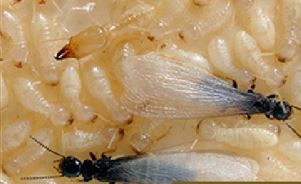
Credit: Rudolf H. Scheffrahn, UF/IFAS
Subterranean termites use mud tubes to travel above ground. Mud tubes consist of soil, subterranean termite feces, and partially digested wood. Tubes are strong evidence for subterranean termites. They protect termites from desiccation and possibly predators (Figure 27). Subterranean termites cause feeding damage with the grain of the wood (Figure 28), sometimes only leaving a thin veneer of undamaged wood at the surface, which is why you may see a termite inspector probing and tapping (Figure 29) the surface of baseboard, door frames, and other areas that are common subterranean termite entry points (Figure 30). Subterranean termites can cause serious damage to structural elements, such as 2 by 4s (Figure 31a and b).
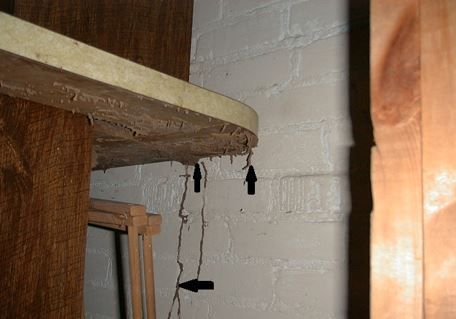
Credit: Faith Oi, UF/IFAS
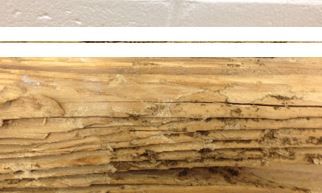
Credit: Faith Oi, UF/IFAS
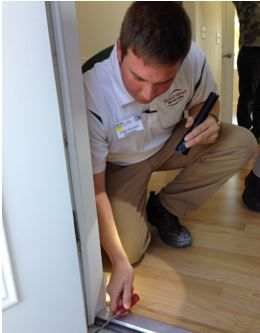
Credit: Faith Oi, UF/IFAS
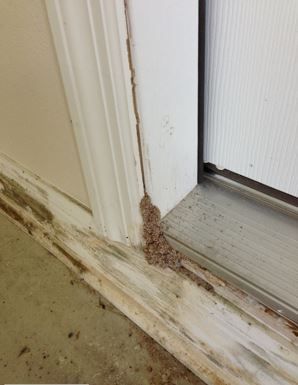
Credit: Faith Oi, UF/IFAS
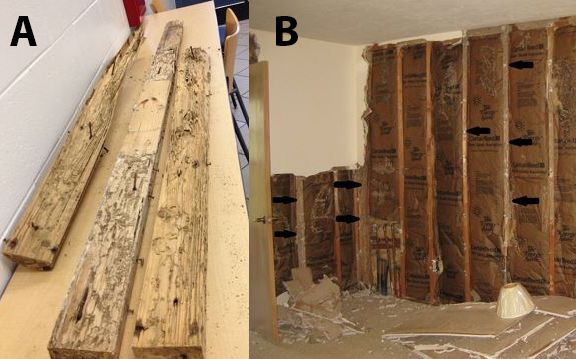
Credit: Faith Oi, UF/IFAS
Special Reference to Formosan Subterranean Termites
Formosan subterranean termites are an invasive species that is spreading through the United States. This species is in the top 100 species on the global invasive species list (Global Invasive Species Database 2023, http://www.iucngisd.org/gisd/100_worst.php). The closely related Asian subterranean termite is also spreading. Treatment will be similar to other subterranean termites, but pest control contracts may be written differently if your home is infested with this species. Some states, like Florida, will allow companies to exclude Formosan and Asian subterranean termites from contract warranties. Read your contracts carefully.
These termites notoriously infest trees (Figures 32 and 33). If you find these termites in trees, call an experienced pest control company to treat them. You may see the pest control company foam the voids with a registered termiticide, place baits at the base of the tree, or use an "aboveground" version of bait that is secured to the tree where Formosan subterranean termites are found. Soil drenches with systemic insecticides labeled for applications may also be used.
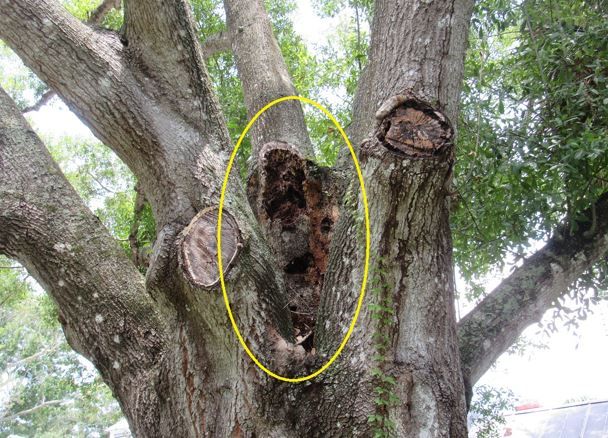
Credit: Faith Oi, UF/IFAS
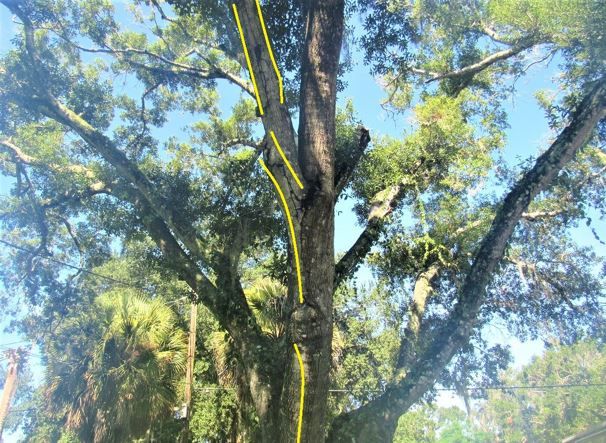
Credit: Faith Oi, UF/IFAS
A myth that still circulates in popular media is that Formosan subterranean termites can "melt concrete" with "acid that shoots from the front of their head." This story is simply not true. The termite does have a structure on its head that exudes a substance, but the substance is not rock-dissolving acid. They secrete a kind of latex that defends them against arthropods about their size.
Additional resources on the Formosan subterranean termite:
- Identification of the Formosan Subterranean Termite
Google "UGA Formosan subterranean termites" or use this link https://extension.uga.edu/publications/detail.html?number=C868&title=identifying-the-formosan-subterranean-termite
- National Invasive Species Information Center: https://www.invasivespeciesinfo.gov/profile/formosan-subterranean-termite
- Formosan Subterranean Termite Program, Florida. https://www.fdacs.gov/Consumer-Resources/Health-and-Safety/Protect-Your-Home-from-Pests/Termites/Formosan-Termite-Program . Comprehensive list of links, including to the University of Florida and University of Georgia resources. FDACS Formosan project contact: Johanna Welch, DPM, Johanna.Welch@FreshFromFlorida.com
- UF/IFAS Subterranean Termite Research website: https://flrec.ifas.ufl.edu/termites-in-florida/
- Related species, Asian subterranean termite: https://edis.ifas.ufl.edu/publication/IN285
- North Carolina State University, Formosan Termite in North Carolina and 2018 Update: https://content.ces.ncsu.edu/formosan-termites-in-north-carolina
- Texas Agrilife Extension: https://agrilifelearn.tamu.edu/s/product/formosan-subterranean-termites/01t4x000004OUUqAAO
Summary of Best Management Practices for Subterranean Termite Prevention Include:
- Schedule regular inspections by someone trained in inspecting for termites.
- Move items out from the garage and other storage areas periodically and look for mud tubes.
- Follow good building construction practices.
- Avoid wood-to-ground contact.
- Avoid creating hidden access by burying exterior wall coverings with soil or mulch.
- Keep an inspection space that is at least 6 inches from the soil line to any exterior wall covering.
- Make sure that the slope of the land around your home allows water to flow away from your home, not toward it.
- Eliminate moisture and other conducive conditions. Do not plant vegetation close to outside foundation walls or direct irrigation toward walls.
- Eliminate debris and hidden access.
- Know where invasive termites have been found. Use the termite distribution map for Florida: https://flrec.ifas.ufl.edu/termites-in-florida/termite-distribution/
Common Methods of Subterranean Termite Control:
- There are two times that a home can be protected from subterranean termites.
- At the time of construction, often called "pre-construction" in the pest control industry.
- After construction, called "post-construction" or "remedial treatments" in the pest control industry.
- The methods of control are similar whether in the pre- or new construction phase or post-construction.
Soil Termiticides
- Application of liquid soil termiticides is still the most common method of termite control during pre-construction and post-construction. The amount of termiticide applied will vary by area to be treated, product label, and soil type.
- The applicator must have knowledge of building construction and equipment to apply the quantity of termiticide that may be required to treat your home.
- Sometimes drilling concrete slabs or concrete block walls is required.
- All soil termiticides registered by the Environmental Protection Agency (EPA) must meet performance standards in "Product Performance Test Guidelines OPPTS 810.3600 Structural Treatments" (https://www.regulations.gov/document?D=EPA-HQ-OPPT-2009-0150-0009).
- In the pest control industry, you may hear of liquid termiticides falling into two (2) categories: repellent and non-repellent chemistries. Describing products in this way may not be technically accurate because at some point, as concentrations increase, any product can become "repellent." However, you may hear these terms when talking with pest management professionals.
- Examples of products that are "non-repellent" contain fipronil (Termidor®, Taurus®), imidacloprid (Premise®, Dominion®), and chlorantraniliprole (Atriset®).
- Examples of products that are "repellent" contain bifenthrin (Bifen I/T®, Talstar®), permethrin (Dragnet™ SFR).
How soil termiticides work: Termites can die either by contacting the soil termiticide or by ingesting treated soil during tunneling. Subterranean termites tend to enter soil treated with "non-repellent" termiticides more readily than soil treated with "repellent" termiticides, yet both types of termiticides eventually provide protection to the structure by acting as a barrier to termite colony foraging into and through the treated soil.
- The performance of soil termiticides over time is dependent on many factors, including putting out the correct amount, soil type, and environmental conditions.
- If the treated soil around your home is disturbed, for instance, by excavations for construction, digging by pets or wildlife, or a washing rain such as may be experienced during a hurricane, be aware that those areas may require another treatment.
- Soil termiticides do not generally kill entire colonies as can occur with some termite baits but can provide structural protection when applied properly and maintained.
What You May See Your Pest Management Professional Do
After pest management professionals inspect your home to determine where the subterranean termites are entering, you may see them:
- Trench around the perimeter of your home (Figure 34) in preparation to treat around your home.
- They may also drill the slab foundation to get the termiticide to areas that would otherwise be inaccessible (Figure 35a and b).
- Treating the trench (Figure 36) and drill holes.

Credit: Faith Oi, UF/IFAS
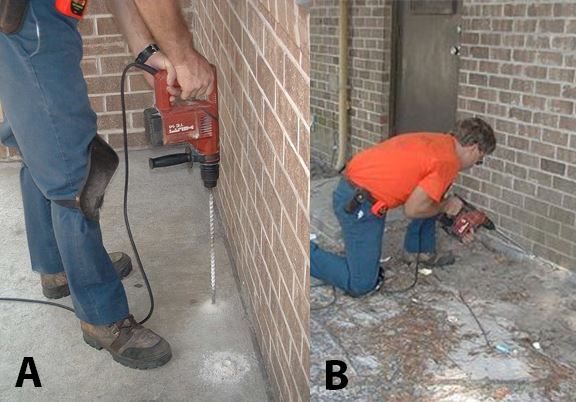
Credit: Faith Oi, UF/IFAS
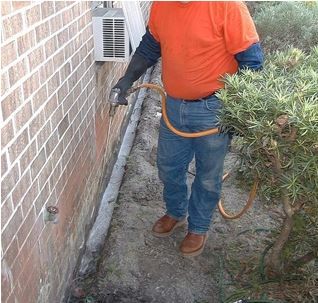
Credit: Faith Oi, UF/IFAS
Baits
- Termite baits have been approved by the Environmental Protection Agency (EPA) since the mid-1990s.
- Examples of EPA-registered baits are: Sentricon®, which contains the active ingredient novaflumuron and Trelona®, which contains the active ingredient novaluron.
- How baits work: Monitoring stations with cartridges containing a cellulose-based material containing an active ingredient are placed in the ground at regular intervals around a home in areas of known termite activity and where conducive conditions (i.e., there is plenty of moisture and/or access) occur. For baits to work, termites must find and feed on cellulosic material containing the toxicant.
- Termite colonies can be eliminated with baits. If there are no termites in the area of the home, the home is no longer at risk.
- The active ingredients in baits are in a class called "insect growth regulators" and delivered in a way that is specific to subterranean termites. These qualities place baits in an "environmentally friendly" category.
- Termite baits can be effective in homes that contain construction that is difficult to treat with liquid termiticides.
- Some states allow baits to be used in "new construction" instead of soil termiticides.
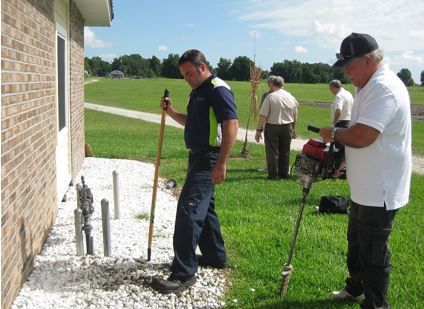
Credit: Faith Oi, UF/IFAS
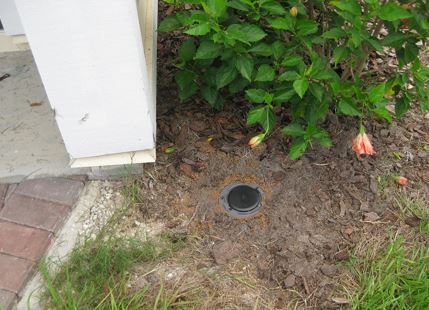
Credit: Faith Oi, UF/IFAS
Wood Treatments with Special Reference to Borates
- Many termiticide labels allow treatment of wooden timbers as a part of termite control. However, borates present a special case of wood treatment because they can be used in new construction.
- Disodium octaborate tetrahydrate is a common active ingredient used in borate products to protect wood against termites and wood-decay fungi.
- Borate treatments for termites are usually only done during the new construction phase.
- Wooden timbers are sprayed with the borate solution and can remain stable for the life of the lumber when protected from weather.
- Examples of borate products are Bora-Care® and Tim-Bor®.
- How it works: Termites must find the treated wooden members of your home and ingest a toxic dose.
- Conehead (Nasutitermes corniger) and related termites do not respond to borates, so borates are not a recommended stand-alone new construction treatment.
What You May See Your Pest Management Professional Do
Most people who buy a new home will not see this phase of the treatment, but if you happen to be there during construction, you may witness it. The builder will call a pest management professional when the framing elements are installed and construction is at the "dried-in" phase. The pest management professional may opt to include a dye marker in the treatment preparation because the borate solution is clear. The label requires that the wooden members be treated to a minimum height of two feet (Figure 39).
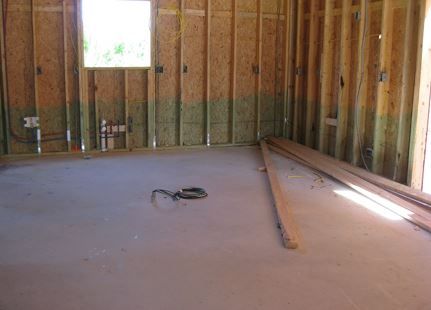
Credit: Faith Oi, UF/IFAS
One of the challenges of a borate treatment is that sometimes framing and other wooden elements are moved or added during the construction process, and this sometimes happens after the pest management professional has done the borate treatment. Unless the builder calls the pest management professional back to treat the modifications, neither the home buyer nor the pest management professional will know that some portions of the structure have not been treated (Figure 40).
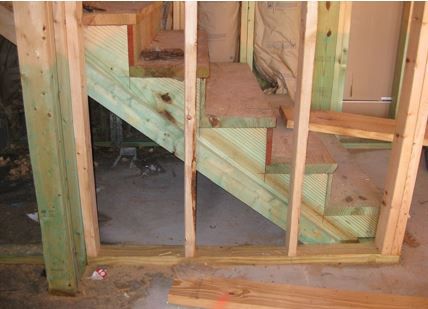
Conehead Termites
The conehead termites also have been called "tree termites." They are a particularly voracious invasive termite that is currently limited to portions of Broward County in south Florida but that may exist elsewhere. Please familiarize yourself with the pictures below and help limit the spread of this invasive termite. Do not attempt to self-treat.
The Florida Department of Agriculture and Consumer Services is leading an eradication effort that has been highly successful. The original site in Dania, FL, has been clear of conehead termites for one year, but diligent surveillance continues.
Homeowners in Florida can help in surveillance and eradication efforts by reporting this invasive termite if you suspect it is in your neighborhood. Please contact: 1-888-397-1517 For more information: https://www.fdacs.gov/Consumer-Resources/Health-and-Safety/Protect-Your-Home-from-Pests/Termites/Conehead-Termite-Eradication-Program.
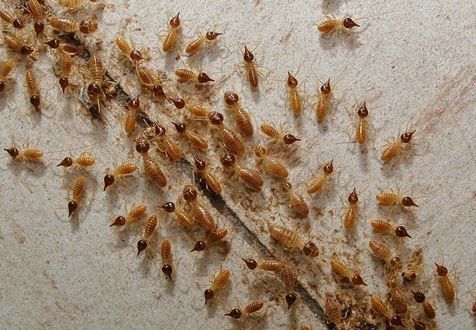
Credit: Rudolph Scheffrahn, UF/IFAS
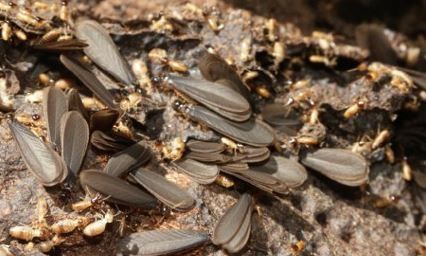
Credit: FDACS

Credit: FDACS
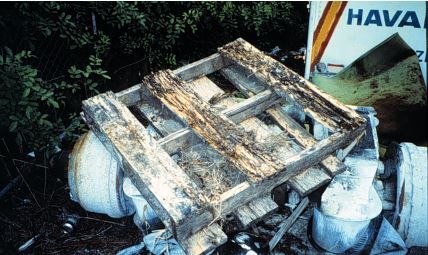
Credit: FDACS
Conclusion
There are approximately 2,750 species of termites globally. Forty-five species have been found in the United States. Most of these termites are not harmful to homes or their contents. If you suspect that you have a termite problem, call a professional pest manager who has experience in termites and other wood-destroying organisms. You may find it beneficial to use more than one termite control method in conjunction with regular inspections and good building and home maintenance practices in your effort to keep your home termite-free.
Homeowner Checklist
- Prevent termites through regular home maintenance.
- Know how to detect termites in areas at risk.
- Identify termites correctly.
- Understand that controlling existing infestations is generally not a do-it-yourself project.
- Contact a licensed pest control company if you suspect termites on your property.
References
Global Invasive Species Database. 2023. Downloaded from http://www.iucngisd.org/gisd/ (Accessed December 4, 2023)
Forschler, B. 2022. Demonstration Project Reporting Detection of Subterranean Termite (Blattodea: Rhinotermitidae) Infestation and Spray Polyurethane Foam. Journal of Entomological Science (2022) 57 (1): 138–144. https://doi.org/10.18474/JES21-47
Oi, F. 2022. A Review of the Evolution of Termite Control: A Continuum of Alternatives to Termiticides in the United States with Emphasis on Efficacy Testing Requirements for Product Registration. Insects 2022, 13(1), 50; https://doi.org/10.3390/insects13010050
Parman, V., and E. Vargo. 2008. "Population Density, Species Abundance, and Breeding Structure of Subterranean Termite Colonies in and around Infested Houses in Central North Carolina." J. Econ. Entomol. 101: 1349–1359. https://doi.org/10.1093/jee/101.4.1349 (Accessed December 4, 2023)
Rust, M., and N.-Y. Su. 2012. "Managing Social Insects of Urban Importance." Annual Review of Entomology 57: 355–375. https://doi.org/10.1146/annurev-ento-120710-100634 (Accessed December 4, 2023)
Scheffrahn, R., and N.-Y. Su. 2000. Florida Dampwood Termites. EENY-122. Gainesville: University of Florida Institute of Food and Agricultural Sciences. Reviewed: March 1, 2021. https://edis.ifas.ufl.edu/in279 (Accessed December 4, 2023)
Acknowledgements
This work is supported by the Crop Protection and Pest Management Extension Implementation Project, grant no. 2017-70006-27149/project accession no. 1013962 from the USDA National Institute of Food and Agriculture. We also thank the pest management professionals who generously shared their expertise: Bryce Hamilton, Linda Prentice, James Sneed. July 18, 2019.